
Alessandro Bonvicino, more commonly known as Moretto, or in Italian Il Moretto da Brescia, was an Italian Renaissance painter from Brescia, where he also mostly worked. His dated works span the period from 1524 to 1554, but he was already described as a master in 1516. He was mainly a painter of altarpieces that tend towards sedateness, mostly for churches in and around Brescia, but also in Bergamo, Milan, Verona and Asola; many remain in the churches they were painted for. Most are on canvas, but a number even of large ones are on wood panel. Only a handful of drawings survive.

Bartolomeo Suardi, best known as Bramantino, was an Italian painter and architect, mainly active in his native Milan.

The Pinacoteca di Brera is the main public gallery for paintings in Milan, Italy. It contains one of the foremost collections of Italian paintings, an outgrowth of the cultural program of the Brera Academy, which shares the site in the Palazzo Brera.
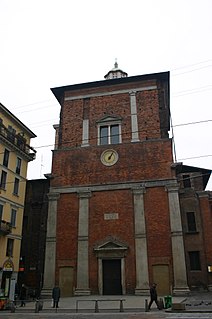
The basilica of San Nazaro in Brolo or San Nazaro Maggiore is a church in Milan, northern Italy.

The Abbey of Santa Maria di Rovegnano is a Cistercian monastic complex in the comune of Milan, Lombardy, northern Italy. The borgo that has developed round the abbey was once an independent commune called Chiaravalle Milanese, now included in Milan and referred to as the Chiaravalle district.

Giovanni Agostino da Lodi was an Italian painter who was active from c. 1495 to c. 1525.

Santa Maria della Passione is a late Renaissance-style church located in Milan, Italy.
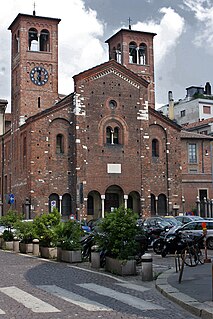
Chiesa di San Sepolcro is a church in Milan, Italy. It was originally built in 1030, but has undergone multiple revisions. The church is located at Piazza San Sepolcro in the historic center of Milan.

The Applied Arts Collection of Milan is located in the Sforza Castle museum complex under the management of the municipality of Milan, Italy. The museum is divided into several sections with particular emphasis on jewelry, ivories, pottery and art glass.
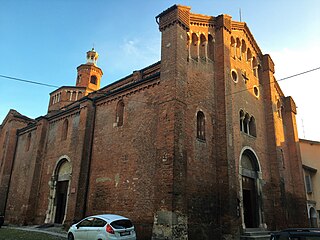
San Teodoro is a Romanesque-style Roman Catholic church in the town center of Pavia, Italy.
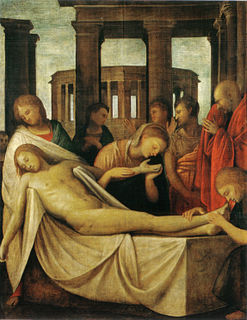
Lamentation over the Dead Christ is an oil painting on canvas of c. 1515–1520 by Bramantino, painted for the church of San Barnaba in Milan. The work was acquired by the Werner family in 1985 and now in the Pinacoteca del Castello Sforzesco in the same city. A copy is now in a private collection.

The Palazzo della Ragione Madonna is a fragment of a fresco of c. 1509-1510 by Bramantino, originally on the façade of the Palazzo della Ragione, Milan, and now in the Pinacoteca di Brera in the same city. Due to a reference by Giovanni Paolo Lomazzo it was long misattributed to Bramante, until it entered its present home in 1808.

Madonna and Child with Eight Saints is an oil painting on canvas of c. 1515–1520 by Bramantino, originally in the church of Santa Maria del Giardino in Milan and now in the Contini Bonacossi collection at the Uffizi in Florence. It belongs to the sacra conversazione genre.

The Adoration of the Kings is a small oil painting on panel of c. 1500 by Bramantino in the National Gallery, London. In it the Holy Family and the Magi are, unusually, joined by an adult John the Baptist, whose Baptism of Christ was celebrated on the same day as Epiphany in the liturgical calendar. At 56.8 cm × 55 cm, it was probably commissioned for private use by an individual rather than for placing in a church, but nothing is known about its early history. The panel entered the National Gallery in 1916 as part of the Layard Bequest.

Christus Dolens or Christ as the Man of Sorrows is a tempera on panel painting by Bramantino, executed c. 1490, in the Museo Thyssen-Bornemisza in Madrid. The original Thyssen-Bornemisza Collection acquired it in 1937 from Countess Teresa Soranza-Mocenigo. A similar work by Bramantino is in the Museo della Certosa in Pavia.

Crucifixion is an oil painting on panel of c. 1510–1512 by Bramantino in the Pinacoteca di Brera, Milan. It was first recorded in that gallery's collections in 1806, without any earlier provenance.
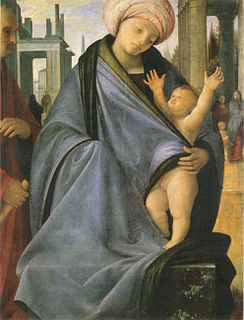
Madonna and Child with a Man or Madonna and Child with a Male Figure is an oil painting on panel of c. 1503–04 by Bramantino in the Pinacoteca di Brera in Milan, which it entered in 1896. The painting had previously been in the collection of cardinal Cesare Monti, left to the Archdiocese of Milan in 1650. Its previous provenance is unknown, though its small dimensions suggest that it was intended for private devotion.

The Kleinberger Madonna is a painting in tempera on panel by Bramantino, dating to before 1508, in the Metropolitan Museum of Art, New York.

Noli me tangere is a fragment of a fresco of c. 1498–1500 by Bramantino depicting Jesus and Mary Magdalene soon after the resurrection. It was originally in the church of Santa Maria del Giardino in Milan and since 1867 in the Pinacoteca del Castello Sforzesco in the same city, to which it was given by Prospero Moisè Loria.


















